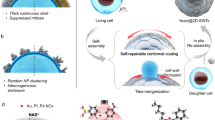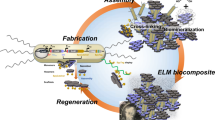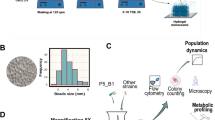Abstract
The encapsulation of enzymes within silica gels has been extensively studied during the past decade for the design of biosensors and bioreactors1,2,3,4,5,6,7,8,9,10,11. Yeast spores and bacteria have also been recently immobilized within silica gels12,13,14,15,16,17 where they retain their enzymatic activity, but the problem of the long-term viability of whole cells in an inorganic matrix has never been fully addressed. It is a real challenge for the development of sol–gel processes18. Generic tests have been performed to check the viability of Escherichia coli bacteria in silica gels. Surprisingly, more bacteria remain culturable in the gel than in an aqueous suspension. The metabolic activity of the bacteria towards glycolysis decreases slowly, but half of the bacteria are still viable after one month. When confined within a mineral environment, bacteria do not form colonies. The exchange of chemical signals between isolated bacteria rather than aggregates can then be studied, a point that could be very important for 'quorum sensing'19.
This is a preview of subscription content, access via your institution
Access options
Subscribe to this journal
Receive 12 print issues and online access
$259.00 per year
only $21.58 per issue
Buy this article
- Purchase on SpringerLink
- Instant access to full article PDF
Prices may be subject to local taxes which are calculated during checkout


Similar content being viewed by others
References
Avnir, D., Braun, S., Lev, O. & Ottolenghi, M. Enzymes and other proteins entrapped in sol-gel materials. Chem. Mater. 6, 1605–1614 (1994).
Zink, J., Valentine, J.S. & Dunn, B. Biomolecular materials based on sol-gel encapsulated proteins. New J. Chem. 18, 1109–1115 (1994).
Livage, J. Bioactivity in sol-gel glasses. C.R. Acad. Sci. Paris IIb 322, 417–427 (1996).
Gill, I. & Ballesteros, A. Encapsulation of biologicals within silicate, siloxane and hybrid sol-gel polymers: an efficient and generic approach. J. Am. Chem. Soc. 120, 8587–8598 (1998).
Reetz, M.T. Entrapment of biocatalysts in hydrophobic sol-gel materials for use in organic chemistry. Adv. Mater. 9, 943–954 (1997).
Dave, B.C., Dunn, B., Valentine, J.S. & Zink, J.I. Sol-gel encapsulation methods for biosensors. Anal. Chem. 66, 1120A–1127A (1994).
Lev, O. et al. Organically modified sol-gel sensors. Anal. Chem. 67, 22A–30A (1995).
Lin, J. & Brown, C.W. Sol-gel glass as a matrix for chemical and biochemical sensing Trends Anal. Chem. 16, 200–211 (1997).
Wang, J. Sol-gel materials for electrochemical biosensors. Anal. Chim. Acta 399, 21–27 (1999).
Collinson, M.N. & Howells, A.R. Sol-gel and electrochemistry. Anal. Chem. 72, 702A–709A (2000).
Wolfbeis, O.S., Reisfeld, R. & Oehme, I. Sol-gels and chemical sensors. Struct. Bond. 85, 51–98 (1996).
Carturan, G., Campostrini, R., Dirè, S. & de Alteris, E. Inorganic gels for immobilization of biocatalysts: inclusion of invertase-active whole cells of yeast (Saccharomyces cerevisiae) into thin layers of SiO2 gel deposited on glass sheets. J. Mol. Cat. 57, L13–L16 (1989).
Pope, E.J.A., Braun, K. & Peterson, C.M. Bioartificial organs I: silica gel encapsulated pancreatic islets for the treatment of diabetes mellitus. J. Sol-Gel Sci. Technol. 8, 635–639 (1997).
Fennouh, S., Guyon, S., Jourdat, C., Livage, J. & Roux, C. Encapsulation of bacteria in silica gels. C.R. Acad. Sci. Paris IIc 2, 625–630 (1999).
Finnie, K.S., Bartlett, J.R. & Woolfrey, J.L. Encapsulation of sulfate-reducing bacteria in a silica host. J. Mater. Chem. 10, 1099–1101 (2000).
Premkumar, J.R., Lev, O., Rosen, R. & Belkin, S. Encapsulation of luminous recombinant E. coli in sol-gel silicate films. Adv. Mater. 13, 1773–1775 (2001).
Premkumar, J.R. et al. Antibody-based immobilization of bioluminescent bacterial sensor cells. Talanta 55, 1029–1038 (2001).
Livage, J., Coradin, T. & Roux, C. Encapsulation of biomolecules in silica gels. J. Phys. Cond. Mater. 13, R673–R691 (2001).
Swift, S. et al. Density-dependent determinant of bacterial physiology. Adv. Microb. Physiol. 45, 199–270 (2001).
Haugland, R.P. Molecular Probe Handbook of Fluorescent Probes and Research Chemicals (Molecular Probes, Eugene, Oregon, 1996).
Villarino, A., Bouvet, O.M.M., Regnault, B., Martin-Delautre, S. & Grimont, P.A.D. Exploring the frontier between life and death in Escherichia coli: evaluation of different viability markers in live and heat- or UV-killed cells. Res. Microbiol. 151, 755–768 (2000).
Coiffier, A., Coradin, T., Roux, C., Bouvet, O.M.M. & Livage, J. Sol-gel encapsulation of bacteria: a comparison between alkoxide and aqueous routes. J. Mater. Chem. 11, 2039–2044 (2001).
Carturan, G., Dal Monte, R. & Muraca, M. SiO2 entrapment of animal cells for hybrid bioartificial organs. Mater. Res. Soc. Symp. Proc. 628, CC10.1.1–CC10.1.15 (2000).
Author information
Authors and Affiliations
Corresponding author
Ethics declarations
Competing interests
The authors declare no competing financial interests.
Rights and permissions
About this article
Cite this article
Nassif, N., Bouvet, O., Noelle Rager, M. et al. Living bacteria in silica gels. Nature Mater 1, 42–44 (2002). https://doi.org/10.1038/nmat709
Received:
Accepted:
Published:
Issue Date:
DOI: https://doi.org/10.1038/nmat709
This article is cited by
-
Functionalizing silica sol–gel with entrapped plant virus-based immunosorbent nanoparticles
Journal of Nanobiotechnology (2022)
-
Sustainability of in vitro light-dependent NADPH generation by the thylakoid membrane of Synechocystis sp. PCC6803
Microbial Cell Factories (2022)
-
Bottlenecks and opportunities for synthetic biology biosafety standards
Nature Communications (2022)
-
Encapsulation of microorganisms for bioremediation: Techniques and carriers
Reviews in Environmental Science and Bio/Technology (2021)
-
Polymer-chlorella cells conjugating with aggregation-induced functionality switch towards hydrogen evolution
Science China Technological Sciences (2020)



